Tatra: The Most Important Car Company You’ve Never Heard Of
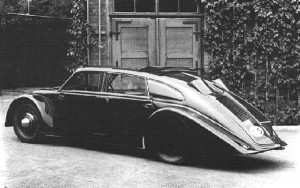
As much as owners hate to hear it, the Porsche 911 does have a direct lineage to the Volkswagen Beetle, Dr. Ferdinand Porsche’s “people’s car” designed for the German government in 1938. Teardrop shaped, rear-engined, slippery and aerodynamic, a 911 is unlike anything else on the road. It’s also set apart by being one of the last cars in the world to have its engine mounted behind the rear axle. So if the 911 came from the Beetle, where did the Beetle come from? That’s not an easy question to answer, but for a direct ancestor, you easily start with Tatra, the Czechoslovakian company that gave us one of the most enduring powertrain layouts in history, and built cars unlike anything that has come before or since.

Behind Mercedes-Benz and Peugeot, Tatra is the third-oldest automaker in the world, releasing its first car (the Präsident) in 1897. But right from the start, the company (then known as Nesselsdorfer Wagenbau-Fabriksgesellschaft) began doing things differently from its contemporaries. In 1900, 20-year-old designer Hans Ledwinka finished the Type A, a rear-engined car capable of 25 miles per hour. He followed it up with the Rennzweier, one of the first purpose-built race cars in Europe, before leaving to develop a steam engine. After World War I, the company reemerged as Tatra, with an older, wiser Ledwinka returning to the company in 1921.
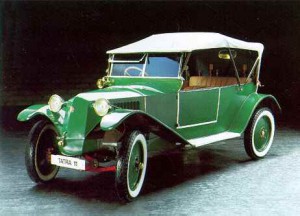 Under Ledwinka, the company released the Tatra 11, a revolutionary car with an air-cooled four-cylinder engine, rigid backbone tube chassis, and independent rear suspension, that was met with some success. By the early ’30s, Ledwinka and his team had taken the lessons learned from the 11 and 12 models, and set about incorporating them into an affordable, small car. He kept the backbone tube chassis but put an air-cooled boxer-four engine in the rear, in hopes of cutting down on noise, vibration and harshness. Outside, the car — known as the V570 — was draped in a teardrop shaped body with round fenders that would become familiar to millions over the next few decades, albeit under a different name.
Under Ledwinka, the company released the Tatra 11, a revolutionary car with an air-cooled four-cylinder engine, rigid backbone tube chassis, and independent rear suspension, that was met with some success. By the early ’30s, Ledwinka and his team had taken the lessons learned from the 11 and 12 models, and set about incorporating them into an affordable, small car. He kept the backbone tube chassis but put an air-cooled boxer-four engine in the rear, in hopes of cutting down on noise, vibration and harshness. Outside, the car — known as the V570 — was draped in a teardrop shaped body with round fenders that would become familiar to millions over the next few decades, albeit under a different name.
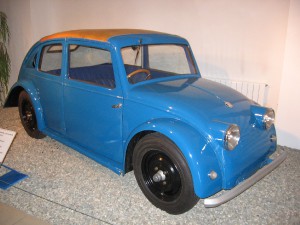
As Hitler enlisted Porsche to helm his KdF-Wagen project, he actively encouraged Porsche to compare notes with Ledwinka. When Porsche unveiled the final KdF-Wagen design in 1938 (soon to be renamed the “Volkswagen”), Ledwinka was shocked to find that Porsche had “borrowed” many key details from the V570 and T97, and filed a lawsuit against him. Unsurprisingly, once the Germans took control of Czechoslovakia in 1939, the lawsuit was dismissed. Years later, when he was asked about Ledwinka’s influence on the Beetle, Porsche said “sometimes I looked over his shoulder, sometimes he looked over mine.”
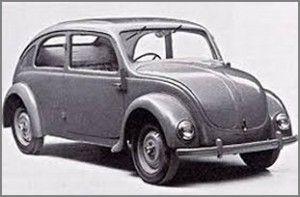 Tatra
Tatra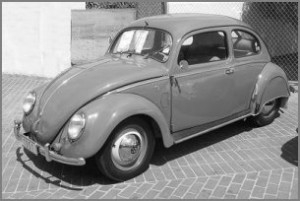 vw
vw
In 1961, Porsche settled the matter out of court, paying Tatra 3 million marks for using the company’s designs. But Ledwinka inadvertently got his revenge against the Nazis much sooner. Like their leader, Nazi officers stationed in Czechoslovakia loved the combination of speed, handling, and luxury in the T87, and adopted them as staff cars.  But like the Porsche 911 years later, they were prone to violent oversteer if handled improperly, and so many Nazis died behind the wheel of a T87 that Czechs began referring to the cars as the “Czech Secret Weapon.”
But like the Porsche 911 years later, they were prone to violent oversteer if handled improperly, and so many Nazis died behind the wheel of a T87 that Czechs began referring to the cars as the “Czech Secret Weapon.”
Czechoslovakia came under Soviet control after the war, and like the Germans, Communist Party officials loved the T87, making it the car of choice for government officials. For a few years, the T97 was updated and renamed the Tatraplan, 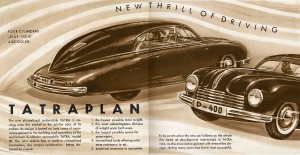 and was even exported as far west as Canada, before anti-communist fervour sealed their fate as exports. By 1955, however, the T87 was growing long in the tooth, and the company released the 603. Analogous to Citroën’s DS but weirder, the 603 retained Tatra’s unique air-cooled V8 mounted out back over the rear axle, and its combination of looks, luxury, and performance made the cars the ultimate in Czech luxury at a time when few Western cars crossed the Iron Curtain.
and was even exported as far west as Canada, before anti-communist fervour sealed their fate as exports. By 1955, however, the T87 was growing long in the tooth, and the company released the 603. Analogous to Citroën’s DS but weirder, the 603 retained Tatra’s unique air-cooled V8 mounted out back over the rear axle, and its combination of looks, luxury, and performance made the cars the ultimate in Czech luxury at a time when few Western cars crossed the Iron Curtain.
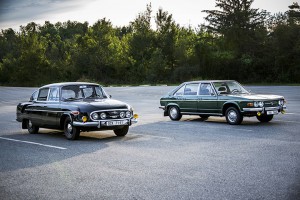 The 603 soldiered on in various iterations until 1975, when it was replaced by the 613, a handsome, almost normal-looking sedan designed by Vignale of Italy. The cars were as popular as ever, but the harsh realities of the communist Czech economy was beginning
The 603 soldiered on in various iterations until 1975, when it was replaced by the 613, a handsome, almost normal-looking sedan designed by Vignale of Italy. The cars were as popular as ever, but the harsh realities of the communist Czech economy was beginning 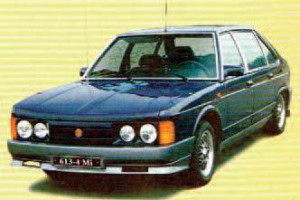 to take its toll on the company. Since the 603, with all the cars were owned by the state, Tatras at the end of their government service were given back to the company. They were then restored, fitted with the latest updates, and sent back out as “new” cars for the next owner to enjoy.
to take its toll on the company. Since the 603, with all the cars were owned by the state, Tatras at the end of their government service were given back to the company. They were then restored, fitted with the latest updates, and sent back out as “new” cars for the next owner to enjoy.
Vignale’s styling held up well, but by the early ’90s, the Tatra was sinking fast in a new free market flooded with Western cars. The 613 was slightly redesigned as the 700, but it was too little too late.
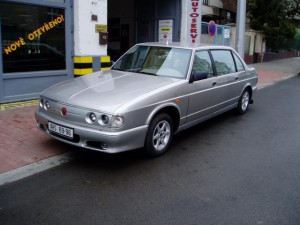
Tatra showed little interest in updating their cars, and even less in trying to break into the Western European markets, and they ended passenger car production in 1999.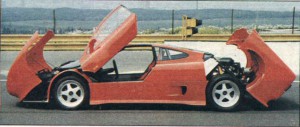

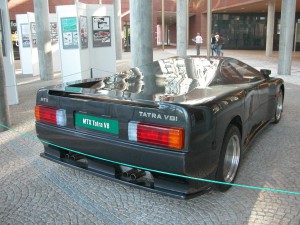
Today, Tatra is still a successful maker of commercial trucks in Europe, but it will always be remembered for its incredibly inventive cars. The company spent most of its lifespan building cars decades ahead of their time. It played a unique role in history, and its styling is still as beguiling today as it was 80 years ago (this featured T87 was just sold by RM Sotheby’s for $132,000 at Monterey Car Week). Its cars were stylistically weirder than Citroëns, they had a pedigree that rivalled Mercedes-Benz, and pioneered a layout that was arguably exploited by Porsche and Volkswagen. If there’s a gearhead out there that doesn’t know about Tatra, it’s about damn time they should.